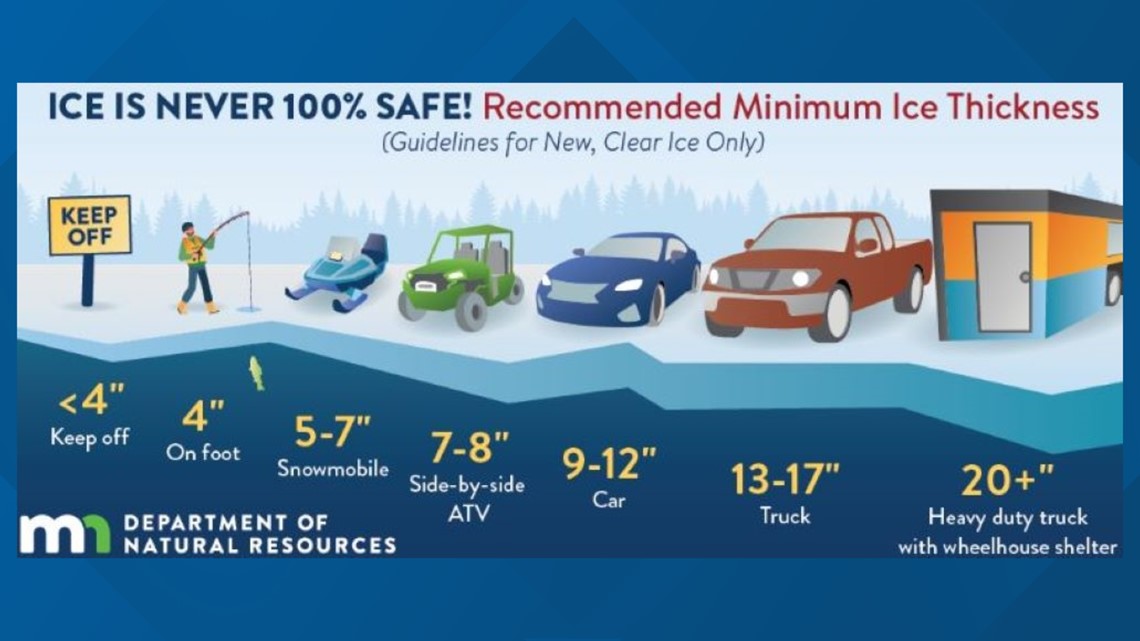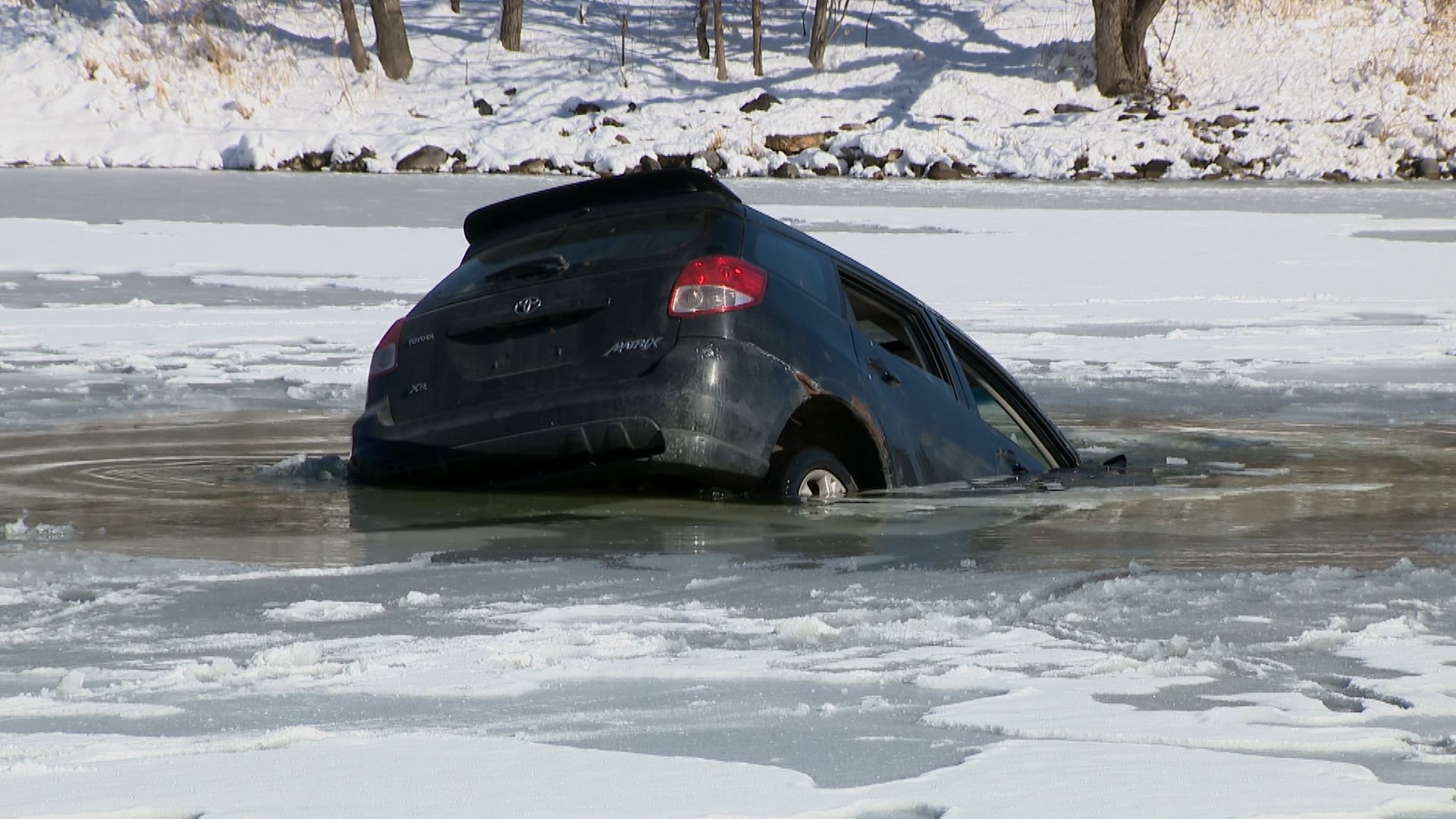MAPLEWOOD, Minn. — The number of people who died falling through the ice on Minnesota lakes so far this year is on track to be double what it was all of last year. So, we thought it was a great time to talk about ice safety.
A couple of years ago, we teamed up with the Minnesota Department of Natural Resources (DNR) to have someone fall through the ice, to teach us how to get out.
This year we decided to do something different — we sunk a car in a lake.
Using GoPros, a drone and a diver, we teamed up again with the Minnesota DNR — and the Ramsey County Sheriff’s Department — to show you exactly what happens if you break through, what you can do to survive and something to keep in mind with electric vehicles.
We were out on Spoon Lake in Ramsey County for the drill. The car didn’t break through the ice as quickly as we thought, considering the conditions, so they drilled holes to make the process go faster.
And then, it happened.
First, the front wheels went through.
“Usually, you're going to have about a minute or so to get out, so it's not like it just instantly sinks to the bottom,” said Arnaud Kpachavi, with the Minnesota DNR.
From the time the front wheels broke through the ice to the time the cabin filled up with water was 1 minute, 41 seconds.
“What we saw here, where it gets hung up on an ice shelf for a little bit first, is typically what I've seen when I've responded to these,” Kpachavi explained.
It took just under 4 minutes for the entire car to slide under the ice.
Keep in mind this is a small car, with no battery or fluids or people or fishing gear. The heavier the car or truck, the faster it will sink. And electric vehicles are even heavier than their gas-powered counterparts — up to 30% heavier because of their battery packs.
BELOW: Back in 2019, the Minnesota DNR showed us what to do if you fall through the ice.
“The doors, a lot of times it won't open, like you can see out there the driver's side door is tight up against the ice. So my guess is if there was someone inside that car right now, they wouldn't be able to open the door," said Kpachavi. "Even if there is no ice right next to the door blocking it, a lot of times the water pressure rushing in will be too much to push the door open, even without a obstruction."
So his advice? Always have the windows down before you drive on the ice. It's your best chance of escaping.
“If you are in a vehicle and it's completely submerged, don't just think it's over and give up," he said. "You've got as much time as you've got breath to get up.”
And Arnaud is experienced at this, he has had to practice this in training.
“Just the big thing there, is remembering which way is up as you are going down, because if you're in a situation where your car flips over, you just want to remember when you come out the window, obviously toward the roof is going to be down at that point,” he added.
But let’s go back to the beginning, before you’re in this predicament. Besides rolling down the windows, there are other things you can do before you get out there.
The first seems like a no-brainer, but check the ice thickness, even if you see someone else already on the lake.


Wear ice picks around your neck, but keep floatation devices, like life jackets, on the seat next to you.
“You don't actually want to be wearing them when you are in the vehicle, because if the vehicle goes down, and you are stuck inside, it can actually make it tough to be able to swim out of a window,” Kpachavi said of the life jackets.
Have a plan with the people in the car, especially if there are kids with you or people not used to going out on a frozen lake. And keep your cell phone in your pocket.
“Getting that 911 call out right away is super important because you're going to be wet, cold, a lot of times a little panicked from what just happened,” he said.
Decide whether or not you're going to wear a seatbelt. While they can protect you from other drivers on the lake, it's one more thing holding you down when you're trying to get out. And if you are belted in, keep a seatbelt cutter on your visor. It can also be used to break windows if necessary.
OK, now you're out and safe, but it's not over yet. You legally have 48 hours to notify the sheriff's department what happened. And for good reason.
“Because if we don't know that, we'll have to assume someone is down in that vehicle, and that's going to generate a huge law enforcement and public safety response,” Kpachavi said.
You also have 30 days to get the car out of the drink on your own dime. That's to make sure the fluids don't leak out into our lakes. It's an environmental concern. And if you don't, you could face fines up to five times what it costs the sheriff's department to do it.
So, now you're prepared — at least as prepared as you can be for the unpredictable.
Here's a list of all the tips to keep you safe on the ice:
- Check the ice thickness. (DNR Ice Thickness Chart)
- Open your windows.
- Put flotation devices on seat next to you.
- Keep your cell phone in your pocket.
- Keep a seatbelt cutter on your visor.
- Try to get out quickly before the car sinks.
- If you are under water, remember which way is up or follow the direction of the bubbles.
- When you are out, call for help.

